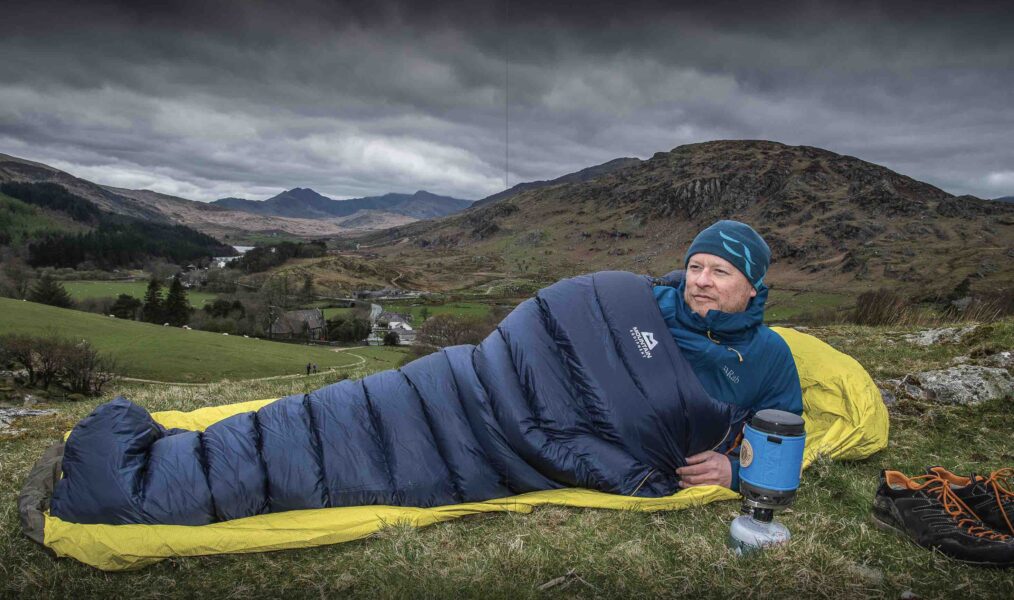With a whole summer of camping adventures to look forward to, Jon Doran tests out eight of the best lightweight down bags currently available…
This month we’ve collected some of the very best lightweight sleeping bags out there ranging from ultra-minimalist, stripped-back, high-tech wonders through to more affordable, but still super-effective choices. The bags we’ve chosen range from two to three-season, but all use down because despite decades of space age technology, your average goose or duck still knows more about light, compressible insulation than most fabric technologists.
Warmth Ratings
All technical sleeping bags are rated in an EN lab test involving temperature sensors and a heated metal mannequin. ‘Comfort Rating’ is a level at which an average woman will sleep comfortably. ‘Comfort Limit’ is the temperature at which an average bloke does the same. ‘Extreme’ is the lowest temperature at which a man should survive for six hours, possibly with added frostbite. Unless you enjoy the idea of playing Russian roulette with death, you can forget ‘Extreme’. Our advice is to choose a bag with a ‘Comfort Limit’ a little below the lowest temperature you expect to encounter, then adjust it according to how warm you sleep. Women often sleep cooler, but everyone differs. If in doubt, go warmer than you might think.
Down Filling
The fill rating is crucial and tells you how much space a given weight of down will occupy once expanded. The higher the figure, the more warmth the down will provide for its weight – 700 upwards is good, the very best bags use 900 or even more fill power goose down. Duck down is more affordable than goose, but tops out at around 750 fill power. A lot of down has a water-resistant treatment to stop it collapsing catastrophically if it gets wet. Think of it as an insurance policy, but with care, you should be fine with standard down. In really low temperatures, water-repellent down will retain loft better on multi-day trips. If you really expect to get you bag wet, synthetic is a better call, but will be heavier. All the down used has been ethically sourced, but for exact details see the brands’ websites.
Construction
Specialist brands are expert at putting the optimum amount of down in each compartment and shaping them for maximum efficiency. Fabrics are also vital. The lighter the materials used, the less the bag will weigh, the smaller it will pack and the easier it will be for the down inside to expand. Lighter fabrics are less robust, but again, with care that doesn’t have to be an issue. Baffles around the neck and shoulder region are particularly important at low temperatures to reduce heat loss through the hood area.
The Right Fit
All the bags we’ve tested use a ‘mummy’ shape to minimise air gaps creating a more efficient, warmer bag. Ideally try before buying to make sure the bag fits you. Many bags are available in two or three different lengths and there are women-specific bags designed to be more effective for the female body shape and with added insulation in strategic areas. Overall you’re looking for a Goldilocks fit – not too snug, not too loose. Talking of which, a good bag will be artfully cut to accommodate feet with a shaped toe-box and have a hood that you can snug down to keep your noggin warm when the going gets frosty.
Features
Some really light bags are stripped back to the minimum with no zips or frills, but most will have some sort of zip to allow ventilation in warmer weather and make it easier to get in and out of the bag. Hoods keep heads warm, insulated strips behind zips minimise heat loss, as do neck and shoulder baffles designed to keep warm air where it’s needed within the bag. Other handy features include small pockets to stash your valuables safely, and sleeves or straps to fasten the bag to a sleeping mat. Adjustment cords you can use easily, even in the dark are a boon too.
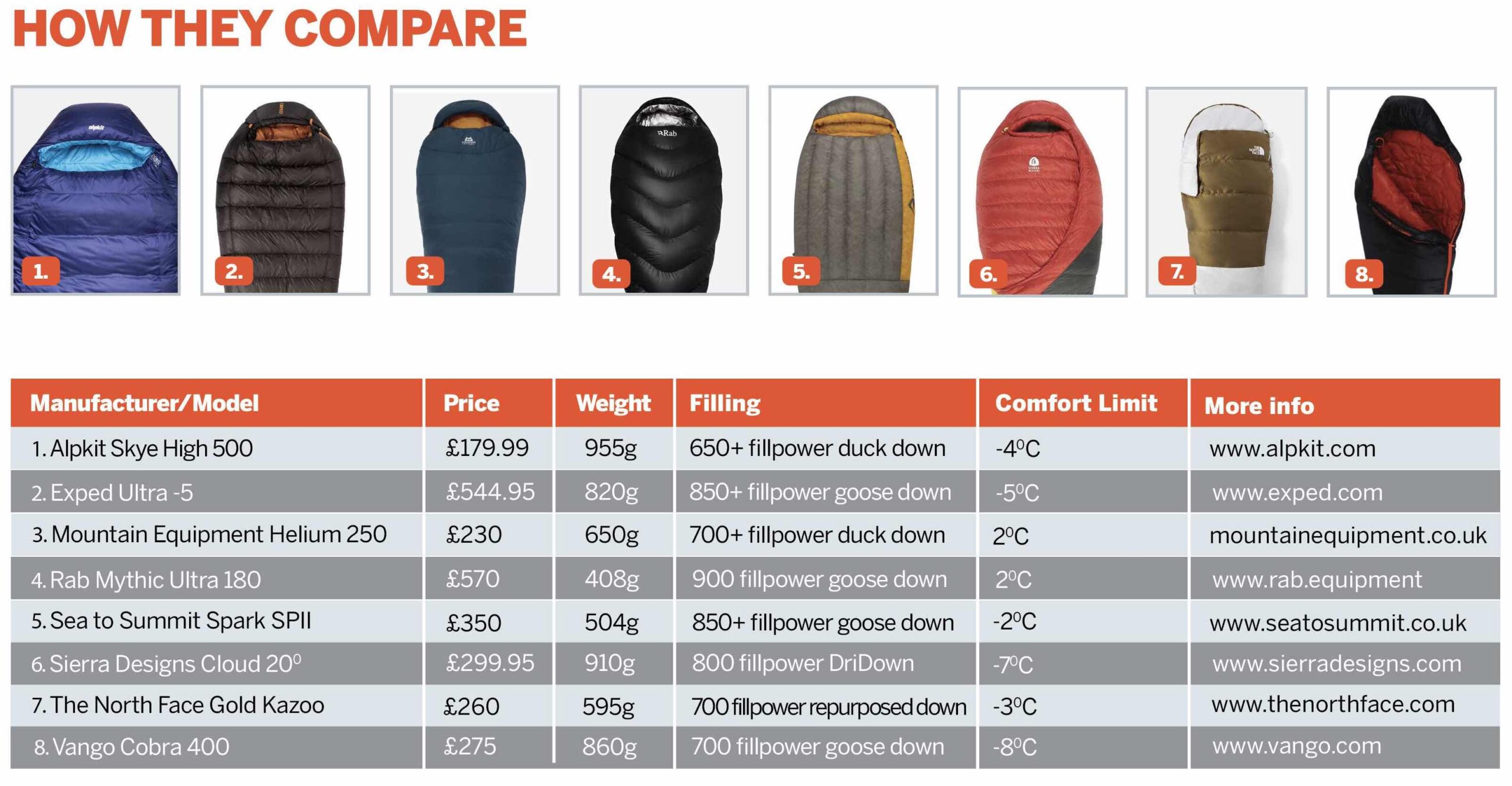 THE TESTS
THE TESTS
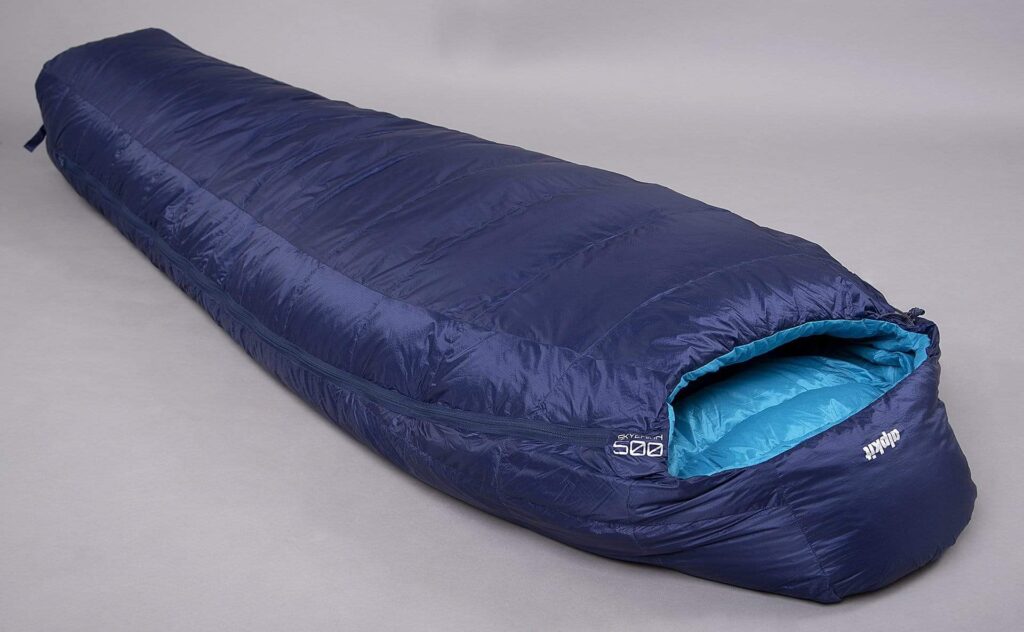
Alpkit Skye High 500 £179.99
It’s tempting to think of the Skye High as the poor relation in this test – after all, it uses slightly lower fillpower duck down and lacks the high-end shimmery light fabric feel of some of the others – but it still boasts a good spec with box-wall construction to optimise warmth on top, shaped trapezoidal baffles at the sides and an internal neck baffle. The bag lofts up nicely and is decently warm, Alpkit’s own ‘useable limit’ is -3˚C, which feels about right. The fit is relatively roomy, which makes it unrestrictive, but also reduces efficiency slightly by allowing larger pockets of air around your body. I also found the main zip slightly reluctant to slide from inside the bag around shoulder level. It’s double ended, so you can vent your tootsies in the event of summer happening. The hood is okay, but I felt that both it and the adjustable shoulder baffle could use a little more down to up the warmth. The bag comes with a traditional nylon compression sac, which makes for decent pack size, but weighs 160g on its own and isn’t waterproof. We’d swap that for a lightweight dry-bag, even though the down has a hydrophobic treatment and the reassuringly substantial 40D fabric is also water repellent. Compared to the early, original SkyeHigh, the bag is definitely a little more polished, but still has a reassuringly solid feel. It’s a little bulkier and heavier than its rivals, but a fantastic value all-rounder if you’re on a tighter budget and can cope with a few extra grammes. For an extra £40 you can upgrade to the Pipedream 400, which uses 750 fillpower goose down and lighter fabrics to save a handy 100g and is also around 3˚C warmer according to Alpkit.
PROS
Good value, Warm, Well featured, Robust feel
CONS
Slightly weighty, Roomy fit, Heavy stuffsack
VERDICT
A great value bag with a robust feel that makes a good all-rounder outside of deep winter conditions
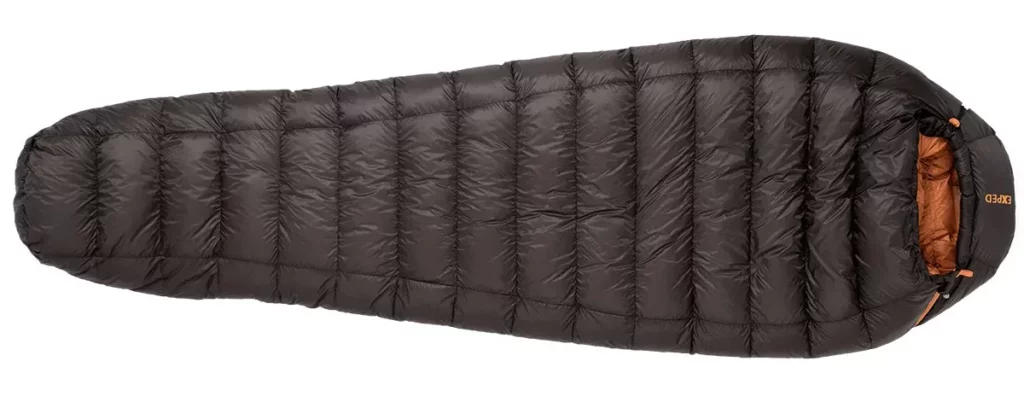 Exped Ultra -5˚ £544.95
Exped Ultra -5˚ £544.95
The Exped Ultra -5˚ is what happens when you take very light 10D Pertex fabrics, top notch, high-lofting, 850 fillpower down and make a sleeping bag from them with impressive attention to detail. It looks and feels like a top quality bag and lofts nicely straight out of the stuffsac. Inside it’s satisfyingly warm. The foot box is good and the hood area complete with ‘elliptical draft collar’ is well stuffed with down to minimise heat escape at lower temperatures. There’s lots of cord adjustment – you can tighten both hood and neck opening independently as well as the neck/shoulder baffle plus internal and external press-studs to give a secure closure. It’s not as polished a system as the Helium 250s, but works well enough. Fit is nicely tailored, but not overly so, which works well thermally. There are actually five different sizes available: S, M and L, plus W (wide) options in M and L length, so you should find one to fit. Presumably the W option allows Exped to use a slimmer fit for the standard bag rather than going for a one-size-fits-all approach. One feature we didn’t really use were the ‘circumferential, I-beam down baffles, which Exped says mean you can shift down around to allow for different sleeping mats/conditions. Basically you can choose to shift down from the underside to up top or vice versa. Mostly though the bag worked well, though we were slightly disappointed by the weight. The bag we have is a L, which weighed a real life 820g, which is what Exped quotes for the M. Perhaps a M would be lighter. If you don’t need sub-zero protection, the Ultra 0˚ should be good down to a few degrees above freezing and weighs around 300g less.
PROS
Warm, Light and packable, Great quality
CONS
Expensive, Cord-grip confusion
VERDICT
A well-designed, quality sleeping bag that lofts up to give reassuring warmth down to sub-zero temperatures – it’s pricey though, and not that light
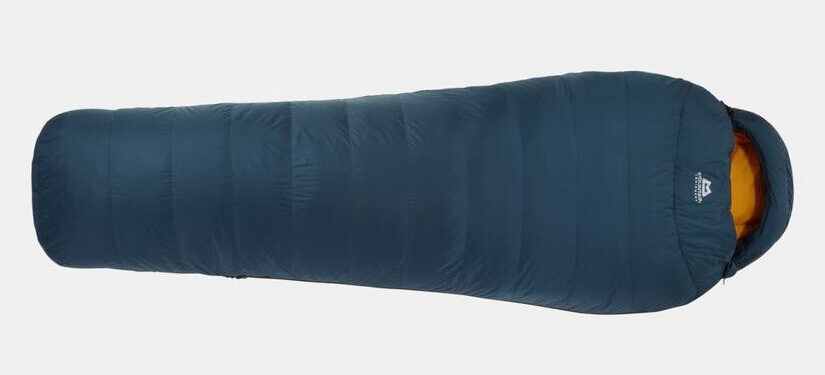 Mountain Equipment Helium 250 £230
Mountain Equipment Helium 250 £230
The Helium 250 is Mountain Equipment’s all-round, lightweight 2/3-season backpacking bag using 600 fillpower duck down in a mix of box-walls and stitch-through compartments. The brand revamped its entire sleeping bag range a few years back, going into meticulous detail on every aspect of the bags and it shows. The detailing is fantastic, with nice touches like a magnetic closure button, cord adjusters you can tell apart in the dark by feel, and great-feeling 20D fabrics inside and out. What it adds up to is a sleeping bag that feels lovely to sleep in. Everything works perfectly; the hood and toe-box are sculpted and well stuffed with down, the fit is neat but not tight, and the double-ended zip slides with sleek, Rolls Royce efficiency. The hood and neck baffles in particular are excellent, managing to cocoon your noggin without feeling claustrophobic and the different-shaped adjustment cords make cinching it all down a breeze, even in the pitch black. Silky soft, pleasingly quiet liner fabric adds to the experience. Did I mention the magnetic fastener? It’s like magic. No contorted fumbling with your wrist bent over backwards, just get it lined up and snap, it’s done. The stuff-bag is a roll-over, waterproof dry-bag and works perfectly and even the storage sac is a bit of genius in cube shape for easier stowing. ME says the 250 is good down to around 1˚C and I used it happily around freezing point. If you want warmer, the Helium 400 is every bit as good – I’ve been using one since 2017 – and is around 6˚C warmer and 160g heavier. It’s not the outright lightest bag out there, but most of the time it’s light enough and the pay-off is a great mix of comfort an efficiency.
PROS
Brilliantly made, Silky smooth, Comfortable, Value for money
CONS
Lightweight rather than ultra-lightweight
VERDICT
The Helium 250 is a little slice of genius that hits the sweet-spot between comfort, warmth and quality
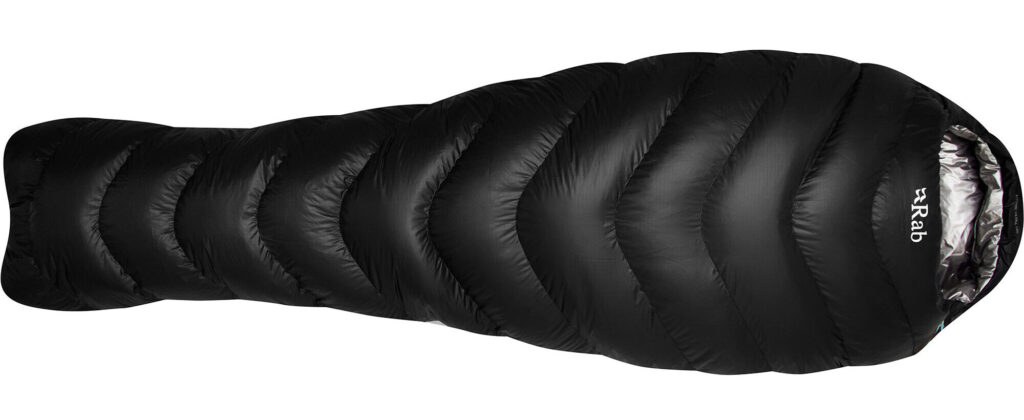
Rab Mythic Ultra 180 £570
This thing is ridiculously light, like something made from gossamer and fairy dust. It weighs just 400g – about the same as a can of cola – yet it will keep you warm to around freezing point. It starts with the down, explosively lofty 900 fillpower stuff, then there’s the super-lightweight 7D fabric inside and out and Rab’s honed construction with trapezoidal, box-wall chambers. Visually obvious is the silvery lining fabric, which uses innovative Thermo Ionic Lining Technology where titanium coats the individual fibres, so they reflect heat without affecting breathability. It means this bag is slightly warmer than its Mythic 200 sibling, while weighing 75g less. The other marginal gain, is replacing a 3/4-length zip with a stubby 1/8 one.The Mythic Ultra almost explodes from its waterproof stuff-sac, expanding into surprising loftiness. Slide inside and it’s instantly warmer than you’d expect. The fit is tailored but with plenty of foot and shoulder room. The short zip allows easier entry and exit rather than venting and works fine for this, though a few times it threatened to snag on the ultra-fine silvery inner fabric. Hood opening and neck-baffle adjustment cords let you snug things up nicely, and because they’re elasticated, there’s still enough give to extricate an arm from the bag if you need to, say to reach a phone or a watch. There’s enough down in that baffle to keep the inner draft free too. If there is a price to pay for the weight saving, it’s the lack of any venting zip option. If it’s hot, your only recourse is simply to pull the bag down over your shoulders. If you want more of the same but warmer, check out the Mythic Ultra 360.
PROS
Diminuitive weight and pack size, Surprising warmth, Thorough design
CONS
Premium pricing, Lacks venting
VERDICT
Awesome, uncompromising bag for anyone who prioritises minimal weight and pack size; a great choice for light-packing or alpinism with a serious pricetag and hard-to-believe performance
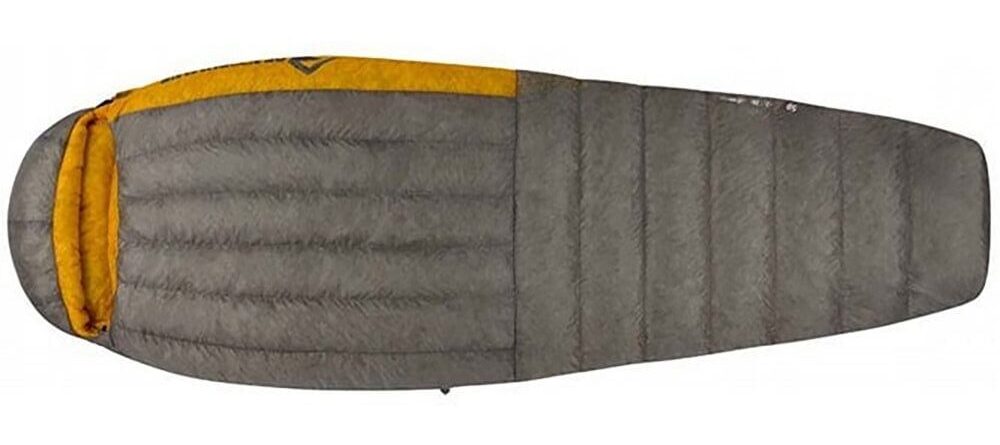
Sea to Summit Spark SPII £350
Liberate the Spark SpII from its tiny compression sac and it’s all ethereal lightness with that slightly crackly feel you get from really minimal fabrics. The outer is 10D, while the inner is an even finer, semi-translucent 7D that means you can see the down fill within. The fill’s high spec too, 850+ ULTRADRY water-repellent premium goose down, that’s among the loftiest here. Plenty of thought has gone into the construction; the bottom area of the bag is stitched through to save weight, while there are vertical box baffles over the chest and torso for extra warmth in key areas. The zip is a half-length one and even the zip’s gauge has been pared back to save a few more grammes. There’s not much compromise here. I was slightly skeptical about the temperature rating, but the bag lofts up really nicely and I found it decently warm down to around freezing point. The fit is very close, which is efficient, but unforgiving if you’re not built like a greyhound. My side shoulders were a snug fit and this in turn, didn’t play well with the very fine zip, which became snag prone under the slightest pressure. I’d rather carry a few extra grammes in exchange for a more robust fastener. Also lacking is a substantial neck baffle and at lower temperatures, you can feel heat seeping away as a result. In milder conditions, which is realistically where this bag is primarily aimed, it’s less of an issue. And if you’re aurally picky, those super lightweight fabrics are slightly noisy in use. Finally, when it comes to storing the bag, the compact, rectangular, zipped stowage is much smaller than anything else here and ideal if you despair of the space most decompressed sleeping bag sacs occupy.
PROS
Very light, High lofting down, Tiny pack size
CONS
Lack of shoulder baffle, Efficient but very snug fit, Snaggy zip
VERDICT
An uncompromising, top quality lightweight bag with a tiny pack size and decent warmth – sorting a couple of niggles would make it even better
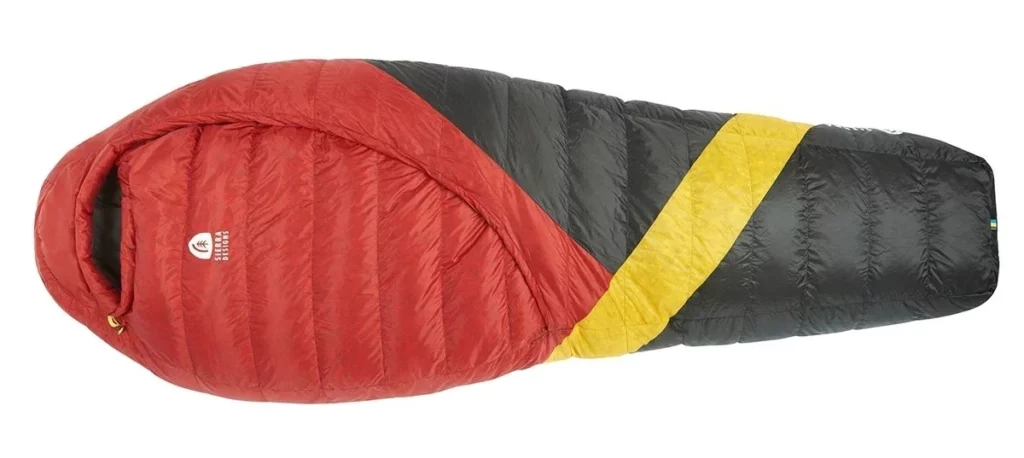
Sierra Designs Cloud 20 £299.95
There’s something fantastically jaunty about the Cloud 20; it’s what you’d expect if you engaged a mad boffin to go back to basics and devise the ultimate sleeping bag. One who didn’t like zips. Or being constrained. And hey, why not colour it half red and half black with a random bright yellow diagonal stripe across the lower half? No zips; the bag has a sort of fold over top that you can wrap around you like a duvet. Or push to one side if it’s warm. There’s a top-half sleeve on the underside to hold your sleeping mat firmly in place which also doubles as a holder for your pillow. Genius, because as we all know, lightweight camping pillows have a sort of eel-like slippery ability to evade any contact with your head.The end result is a really pleasant, unrestrictive sleep that’s ideal for anyone who feels constrained by conventional zipped bags and is willing to trade a little performance for added comfort. Of course not having a zip means you can’t vent your feet. No worries, there’s a cunning, ‘self-sealing’ vent in the underside of the toe-box so you can expose your tootsies at will. It’s not all novelty design. High 800 fillpower, water-resistant down, light 15D fabrics and classic box-wall construction mean this is a really warm, comfortable bag. The hood doesn’t seal as well as a normal bag though and while as a left-side sleeper, I found I could anchor the top section in place, it doesn’t feel as secure if you lie on your right side where there would be nothing for the top-flap cord tensioner to pull against. Maybe there’s a case for an option where the flap opens the other way?
PROS
Unrestricted comfort, Good performance, Mat sleeve works well
CONS
Arguably works best for left-side and back sleepers, Bald patch over mat
VERDICT
A proper feel-good, unrestrictive, sleeping experience packing some genuinely innovative features, but without sacrificing warmth, weight or pack size
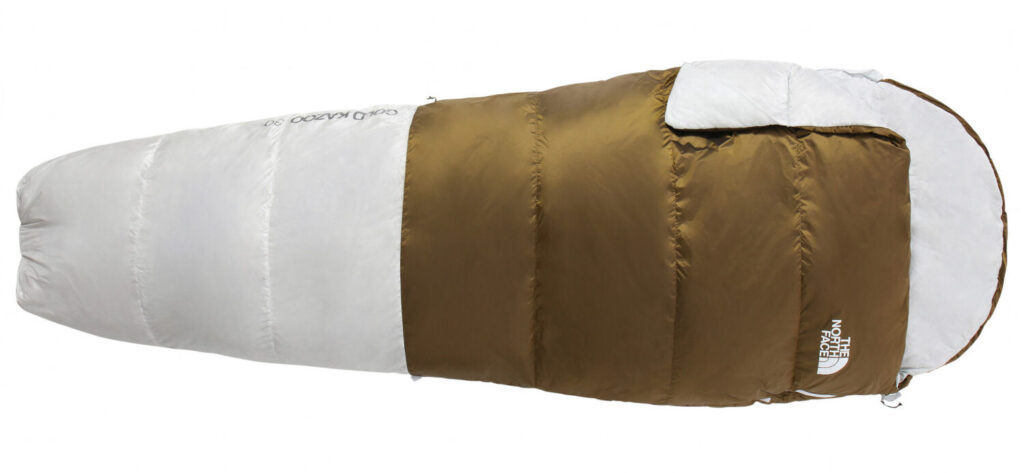
The North Face Gold Kazoo Eco £260
The first things that strike you about the Gold Kazoo are the glitzy gold and light-grey colour scheme and, on closer inspection, two little down-filled, ear-like pockets around where your shoulders sit. The rest, as you’d expect from TNF is a good quality design using rare eco-friendly 700 fillpower recycled down housed in 100% recycled lightweight 20D Nylon material. It packs down into a small, neat package in the mini compression-sac provided and, according to The North Face should be good down to around 2˚C, though we think that’s optimistic. The cut of the bag is very generous, which doesn’t help thermal efficiency and means the down is maybe spread thinner than it might be. On top of that, the lay-flat hood, while uncomplicated, doesn’t offer much warmth and there’s no way of cinching down the main opening of the bag making things a little draughty and inefficient up top. Those odd ear-like pockets? Turns out they’re for tucking your hands into if you want to sprawl out duvet style. There are two side-zips, a half-length one on one side and much shorter one on the other, undoing both makes for excellent summer tent sprawling compared to a standard, single-zip design. Realistically, we’d say this is more of a summer bag than the 2-3 season one that the temperature ratings suggest. Look at it like that and the minimalist hood design and closure matter less than its light weight, modest pack size and relaxed roomy fit. Kudos to The North Face for using both repurposed/recycled down for the filling and recycled polyamide fabrics throughout, the only bag here to do so.
PROS
Recycled fabrics and down, Intuitive hand pockets, Summer-friendly design
CONS
Hood could be better, Temperature ratings seem optimistic, Generous fit
VERDICT
View the Gold Kazoo as a decent spring/summer bag and you’ll be about right, but big credit to TNF for the use of recycled materials
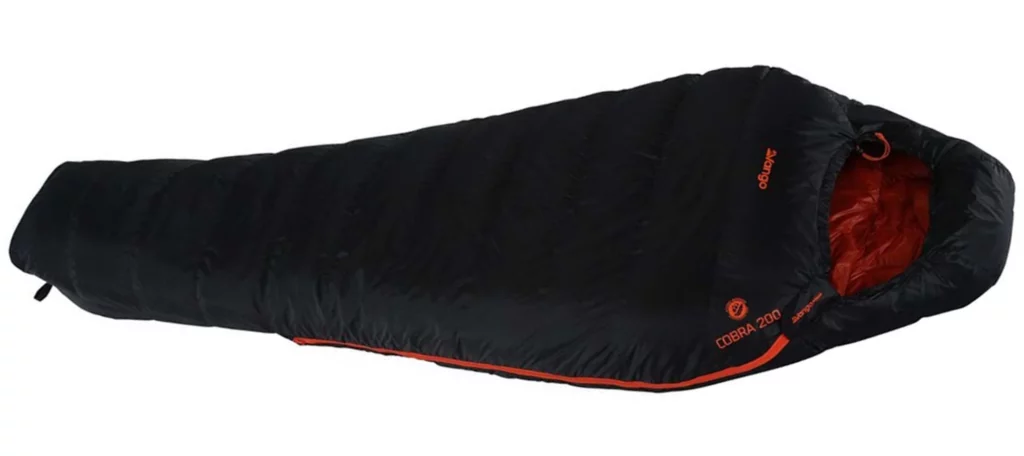 Vango Cobra 400 £275
Vango Cobra 400 £275
The Cobra 400 isn’t the most polished sleeping bag here, but it does a solid, competent job down to just below zero and packs away into an impressively compact package in the supplied stuffsac. There are some interesting construction features too; the box-wall down compartments use welded seams rather than stitching and there something called Thermal Reverb, an aluminised layer which ‘reflects heat back to the user’. In use the 700 fillpower doesn’t quite have the explosive loftiness of some of the higher fillpower down bags here, but it’s still a pleasantly cosy place to be and solidly three-season capable down to a few degrees below freezing. Stuff to be aware of include a toe-box that may be a little cramped for those with big feet, a slightly clunky zip – it tended to stick around shoulder level – and and a neck/shoulder baffle that could do with a little more filling when things get proper cold. I also found the cord grips for the hood and shoulder baffles slightly clunky to use when in the bag. There are lots of pluses here though: the ethically-sourced 700 fillpower goose down has a water-repellent treatment to help deal with dampness (four times longer than untreated down, says Vango); the shape is generally good, not too snug or loose and the hood works fine keeping your head well protected when the thermometer goes into sub-zero mode. A proper full-length zip means you can vent your feet when temperatures climb and the 20D fabric feels light but still decently robust. One small point; the compression sac is so small that packing the bag away feels like an advanced hand-strengthening exercise – a slightly larger one would be better!
PROS
Packs small, Interesting technical features, Decently warm
CONS
Not the most polished bag, Shoulder baffle could use more fill
VERDICT
While it’s not as swanky as some of the bags we tested, the Cobra makes use of interesting construction and decent down to make for a solid, 3-season all-rounder
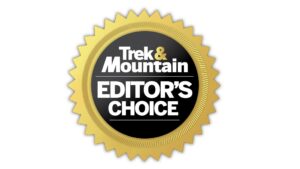
OVERALL VERDICT
All the bags tested here are very capable and will do the job, however we have chosen two as our Editor’s Choices, one no-expense-spared model, and one more affordable model. The 400g Rab Mythic Ultra 180 is an astonishingly light, compact sleeping bag that’s warmer than it has any right to be. The only real compromise it makes is a short zip. If you sleep warm it’ll serve you for anything from backpacking through to ultra-lightweight summer mountaineering. The down is amazingly lofty and the bag design is dialled. If you need warmer, the Mythic Ultra 360 is an all-year bag that weighs just 606g and is good for -8˚C. Bonkers, but at a price.
Also fantastically well designed is the Mountain Equipment Helium 250, just a near flawless lightweight, well-priced all-round bag that was a pleasure to use. Lovely fabrics, brilliant detail touches and really excellent value.
A leftfield stand-out is the innovative Sierra Designs, zipless Cloud 20˚, a great choice for people who find standard mummy bags restrictive and a lovely all-rounder which offers a duvet-like sleeping experience with bag efficiency.
Of the rest, the Spark SPII is light, warm and compact, but exacting in use and the Exped Ultra is a lovely, top quality bag, that perhaps feels like it should be warmer. The Alpkit and Vango offerings are both unflashy but effective, and great value if you’re on a tighter budget. Finally The North Face Gold Kazoo Eco deserves plaudits for its recycled down and fabrics and is a good choice in milder conditions.


